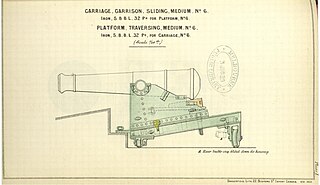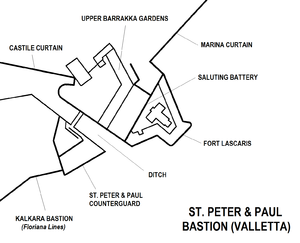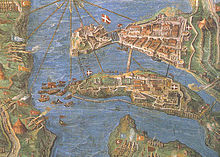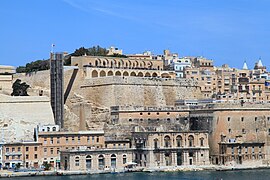
The Rinella Battery was a Victorian battery in Kalkara, Malta. It is commonly referred to as Fort Rinella, although it was never classified as a fort while in use. It was armed with an Armstrong 100-ton gun, which survives; the only other surviving gun is at the Napier of Magdala Battery, Gibraltar.

Fort Manoel is a star fort on Manoel Island in Gżira, Malta. It was built in the 18th century by the Order of Saint John, during the reign of Grand Master António Manoel de Vilhena, after whom it is named. Fort Manoel is located to the north west of Valletta, and commands Marsamxett Harbour and the anchorage of Sliema Creek. The fort is an example of Baroque architecture, and was designed with both functionality and aesthetics in mind.

Fort Saint Elmo is a star fort in Valletta, Malta. It stands on the seaward shore of the Sciberras Peninsula that divides Marsamxett Harbour from Grand Harbour, and commands the entrances to both harbours along with Fort Tigné and Fort Ricasoli. It is best known for its role in the Great Siege of Malta in 1565.

Fort St. Angelo is a bastioned fort in Birgu, Malta, located at the centre of the Grand Harbour. It was originally built in the medieval period as a castle called the Castrum Maris. It was rebuilt by the Order of Saint John as a bastioned fort called Fort Saint Angelo between the 1530s and the 1560s, and it is best known for its role as the Order's headquarters during the Great Siege of Malta of 1565. A major reconstruction to designs of Carlos de Grunenbergh took place in the 1690s, giving the fort its current appearance.

Saint James Cavalier is a 16th-century cavalier in Valletta, Malta, which was built by the Order of St John. It overlooks St James' Bastion, a large obtuse-angled bastion forming part of the Valletta Land Front. St James was one of nine planned cavaliers in the city, although eventually only two were built, the other one being the identical Saint John's Cavalier. It was designed by the Italian military engineer Francesco Laparelli, while its construction was overseen by his Maltese assistant Girolamo Cassar. St James Cavalier never saw use in any military conflict, but it played a role during the Rising of the Priests in 1775.

The Upper Barrakka Gardens are a public garden in Valletta, Malta. Along with the Lower Barrakka Gardens in the same city, they offer a panoramic view of the Grand Harbour.

The SBBL 32-pounder was a British smooth-bore breech loading gun made by converting older 32-pounder 42 cwt smooth-bore muzzle-loading guns.
The following is a history of the activities of the Royal Corps of Signals of the British Army while stationed in Malta. Signal troops were stationed in the country from 1923 to 1979.

Lascaris Battery, also known as Fort Lascaris or Lascaris Bastion, is an artillery battery located on the east side of Valletta, Malta. The battery was built by the British in 1854, and it is connected to the earlier St. Peter & Paul Bastion of the Valletta Land Front. In World War II, the Lascaris War Rooms were dug close to the battery, and they served as Britain's secret headquarters for the defence of the island.

The Lascaris War Rooms are an underground complex of tunnels and chambers in Valletta, Malta that housed the War Headquarters from where the defence of the island was conducted during the Second World War. The rooms were later used by NATO and are now open to the public as a museum.

The fortifications of Malta consist of a number of walled cities, citadels, forts, towers, batteries, redoubts, entrenchments and pillboxes. The fortifications were built over hundreds of years, from around 1450 BC to the mid-20th century, and they are a result of the Maltese islands' strategic position and natural harbours, which have made them very desirable for various powers.

San Rocco Battery was an artillery battery in Kalkara, Malta, built by Maltese insurgents during the French blockade of 1798–1800. It was the last in a chain of batteries, redoubts and entrenchments encircling the French positions in Marsamxett and the Grand Harbour. It was built to control the entrance to the harbour as well as the French occupied Fort Ricasoli. The battery was continually being fired upon by the French at Fort Ricasoli, which was located about 700 m (2,300 ft) away.

Mistra Battery, formerly also known as Despirasse Battery, is an artillery battery in Mistra Bay, Mellieħa, Malta. It was built by the Order of Saint John in the 18th century as one of a series of coastal fortifications around the coasts of the Maltese Islands.

Tas-Samra Battery was an artillery battery in Ħamrun, Malta, built by Maltese insurgents during the French blockade of 1798–1800. It was part of a chain of batteries, redoubts and entrenchments encircling the French positions in Marsamxett and the Grand Harbour.

The Corradino Batteries were a series of artillery batteries on Corradino Heights, near Paola, Malta, that were built by Maltese insurgents during the French blockade of 1798–1800. The batteries formed part of a chain of batteries, redoubts and entrenchments encircling the French positions in Marsamxett and the Grand Harbour.

The fortifications of Valletta are a series of defensive walls and other fortifications which surround Valletta, the capital city of Malta. The first fortification to be built was Fort Saint Elmo in 1552, but the fortifications of the city proper began to be built in 1566 when it was founded by Grand Master Jean de Valette. Modifications were made throughout the following centuries, with the last major addition being Fort Lascaris which was completed in 1856. Most of the fortifications remain largely intact today.

The fortifications of Senglea are a series of defensive walls and other fortifications which surround the city of Senglea, Malta. The first fortification to be built was Fort Saint Michael in 1552, and the majority of the fortifications were built over the next decade when it was founded by Grand Master Claude de la Sengle. Modifications continued until the 18th century, but large parts of the fortifications were demolished between the 19th and 20th centuries. Today, all that remain of Senglea's fortifications are the seaward bastions and part of the land front.

Ġnien is-Sultan, also known as the Giardino della Marina, the Grand Master's Garden or Lascaris Garden, was a garden in Valletta, Malta. It was established in the 17th century by Giovanni Paolo Lascaris, and included a summer residence for the Grand Master. The garden included several Baroque elements designed by Francesco Buonamici.

The Royal Malta Artillery (RMA) was a regular artillery unit of the British Army prior to Malta's independence. It was formed in 1889, having been called the Royal Malta Fencible Artillery from 1861 until 1889.





























